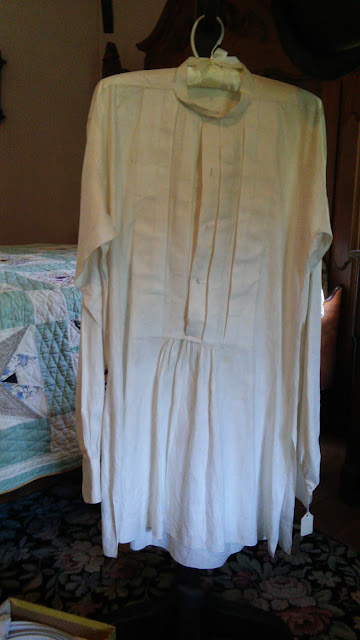This has been my plan since before The Refashioners began. Once I heard what this year's theme was I knew I would be making this jacket. But, dang, I am a procrastinator.
"The jacket will happen." I kept thinking.
"It's too hot to make a jacket now." I told myself.
So here we are, at the end of September, the day before The Refashioners contest ends. It's finally begun to cool off, and my jacket is finally done!
I began it last week. I picked McCall's M6800 as my base pattern. I gathered up my materials. The the cutting began. I seam ripped open the inner leg seam on pair after pair of jeans. 6 pair for the body of the jacket.
Once the seam ripping was done I laid the jeans out flat and cut out the skirt sections of the jacket. Then I squeezed the bodice section of each piece out of what remained once the skirt section was cut out.
Then I was ready to cut out the sleeves, and I was running out of decent jeans. The few pairs that remained were very stained and torn. So, I picked out the best of the worst for the main sleeve pieces, trying my best to avoid the biggest stains. For the smaller sleeve piece I used a pair of jean legs left over from making cut offs once upon a time.
Finally everything was cut out and construction could begin. Construction wasn't hard at all, just time consuming. Lots of long seams to sew, serge, and top stitch with white thread for a finished look. Then came my favorite part, the details.
While planning this jacket I decided I wanted to attempt to use a jeans waistband to make the neckline. So I choose a waistband out of my stash of old jeans and sewed it onto the jacket neckline. Then I pleated the upper edge of the waistband neckline until it lay flat.
I stitched each pleat down flat.
The result turned out just as I'd hoped!
One of the only the only things on this jacket not reused from jeans are the three metal buttons down the front. They came from my best friend's mom. I've had them in my stash for months, just waiting for the perfect project. This was it.
In keeping with the reusing of the original jeans pieces, I added three back jean pockets to the front of the jacket. Two on the skirt, and one as the breast pocket.
In addition to those, just because I love pockets, there are two large inseam pockets in the skirt, made from the scraps of a shirt refashion from last year. With 5 pockets total I should have plenty of places to stash stuff!
Whew, all that planning, all that work. I wasn't sure if I was going to get it done in time. Finally, this evening, with less than 24 hours before the end of The Refashioners 2016, and about 45 minutes till dark, my jacket was done! All I needed now was a willing photographer. I threw on my crinoline, my fabulous green wrap dress, and my newly completed jacket. Outside I went to track down a family member.
My dad and brothers are building lean-to addition onto the barn, and they graciously paused their work to snap a few pictures for me!
All done! A long full denim jacket made from my old jeans.
Complete with paint stains from painting my friend's room, a grease stain from fixing my truck, ink stains from tattooing goats, and glitter glue from who knows what.
With all that I don't need to worry about messing it up, so now all that's left to do is wear my new jacket as much as possible!
A HUGE, HUGE Thank You to Portia from Makery for organising The Refashioners 2016. My old jeans stash is much diminished! I feel like I need to shrink my fabric stash before I leave on the World Race in January and the Jeanius theme has definitely helped me with that!
Now, has this contest greatly inspired me so that I have more jeanius ideas than jeans left to refashion? Of course! Just like with the men's shirt refashions of last year, this is not the end of my jeans refashioning. There will be more!




















































